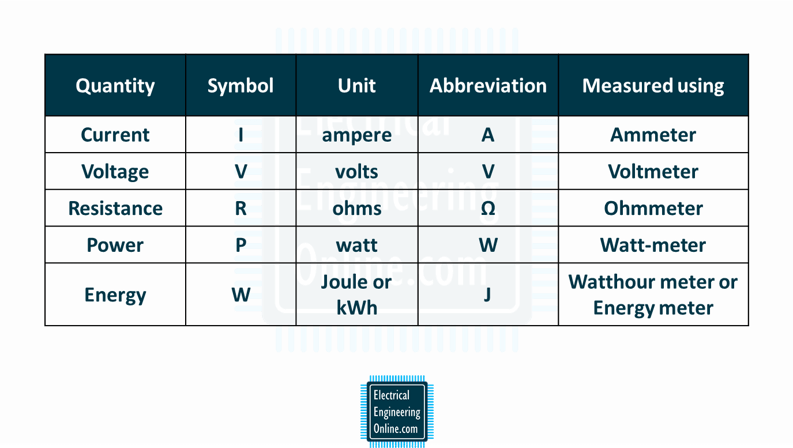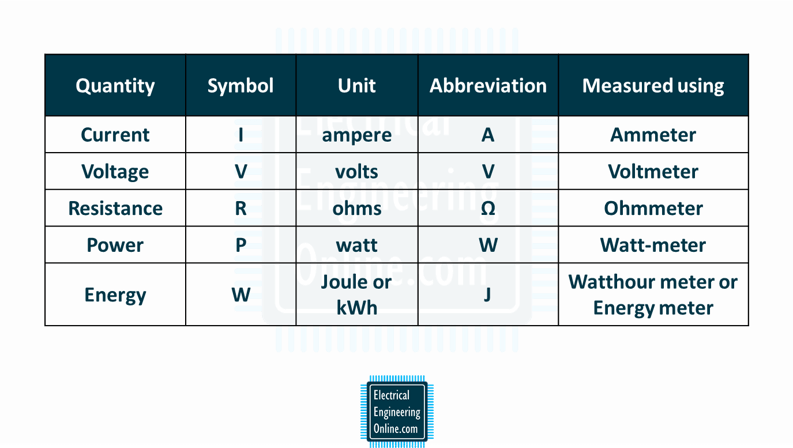Electricity is essential to modern life. It powers everything around us, from lights and appliances to computers and smartphones. In order to understand how electricity and electrical engineering works, it’s essential to have a basic understanding of the electrical properties that underlie this phenomenon. Electrical Engineering Online Article on Basic Electrical Engineering Properties and Quantities illustrates basic concepts, definitions, and formulae linked to current, voltage, resistance, power, and energy.

Current
Electric current is a fundamental property and a basic Electrical Engineering and physics concept. It refers to the flow of charged particles, such as electrons, through a conductive material. The mathematical equation that describes electric current is I = Q/t, where I represents the current, Q represents the charge, and t represents time.
By Definition, Electric current is the amount of charge flowing through a circuit per unit of time. Electric current is often measured in units of amperes (A). Understanding how electric current works is essential for designing and building electronic devices, power systems, and other technological innovations.
Voltage
Electric voltage, or potential difference, refers to the difference in electric potential energy between two points in an electric circuit.
The mathematical equation that describes electric voltage is V = W/Q, where V represents voltage, W symbolizes work, and Q represents charge. In simpler terms, the electric voltage is the amount of work required to move a unit charge from one point to another in a circuit. Electric voltage is often measured in units of volts (V), and it is a crucial concept in electronics, electrical engineering, and physics. Electric current cannot flow without voltage, and electronic devices cannot operate. Voltage is the driving force needed to compel the current flow through a circuit.
Resistance
Besides voltage and current, resistance is another imperative electrical property. The term resistance represents the opposition to the flow of electrical current through a conductor. Resistance is measured in ohms (Ω), and the symbol R often represents it. The higher the resistance of a conductor is, the more difficult it is for current to flow through it. The mathematical equation that describes resistance is R = V/I, where R represents resistance, V represents voltage, and I represents current. In other words, resistance is the ratio of voltage to current in a circuit. This equation is known as Ohm’s law, named after German physicist Georg Simon Ohm, who first discovered the relationship between voltage, current, and resistance. Resistance can be measured using ohmmeters.
Power
Generally, Power is defined as the physical quantity that measures the rate at which work is done. It is described as the energy required to perform a task or move an object over a certain distance in a specified amount of time.
In Electrical Engineering, Power is a measure of the rate at which an electrical circuit transfers energy. The circuit’s Power is determined by the circuit’s voltage, current, and resistance.
The SI unit of Power is the watt (W), defined as one joule per second. This is equivalent to the rate of energy transfer or work done when one joule of energy is expended in one second. The mathematical equation formula for Power is P = W/t, where P is Power, W is the amount of work done, and t is the time taken to do the work.
Energy
Energy is defined as the capacity of a system to perform work. It is an essential concept in Electrical Engineering and physics. It is used to explain various phenomena in the natural world. The SI unit of energy is the joule (J), defined as the amount of work done when a force of one newton is applied over a distance of one meter. In Electrical Engineering, energy is expressed in kilowatt-hours, and it is the most familiar example of energy that we use in our homes and pay for on our utility bills. Energy is often confused with Power, which is the rate at which energy is used or produced. Power is measured in watts (W) and is equal to the energy used or produced per unit of time. For example, a light bulb may have a power rating of 60 watts, which means it uses 60 joules of energy per second.
Concluding Remarks
So, that was all about the five basic properties of electrical circuits. Understanding these basic electrical properties is essential for anyone working with electrical circuits. Whether you’re an engineer, electrician, or just someone interested in learning more about electricity, having a solid understanding of these concepts is essential. With this knowledge, you can begin to explore how electricity shapes our modern world, from powering our homes and businesses to driving innovation and progress across countless industries.

